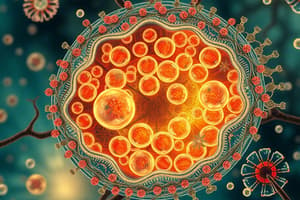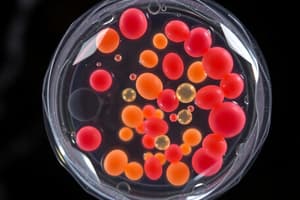Podcast
Questions and Answers
What are the primary functions of proteins in biological systems?
What are the primary functions of proteins in biological systems?
- Catalyzing chemical reactions and providing structural support (correct)
- Transmitting signals and providing nutritional value
- Carrying genetic information and storing energy
- Energy storage and insulation
Which statement accurately describes the role of nucleic acids?
Which statement accurately describes the role of nucleic acids?
- They provide energy and structural components in cells.
- They serve as the primary energy source for cellular processes.
- They act as enzymes to speed up chemical reactions.
- They store genetic information and transfer it during protein synthesis. (correct)
How do carbohydrates function in living organisms?
How do carbohydrates function in living organisms?
- As the main components of cellular membranes
- As catalysts in metabolic reactions
- As a primary source of energy and building blocks for structural components (correct)
- As long-term energy storage molecules
What is homeostasis?
What is homeostasis?
Which statement best describes the relationship between DNA and genes?
Which statement best describes the relationship between DNA and genes?
Which of the following components is NOT commonly found in all cells?
Which of the following components is NOT commonly found in all cells?
What role does cholesterol play in animal cell membranes?
What role does cholesterol play in animal cell membranes?
Which organelle is primarily responsible for energy production in the cell?
Which organelle is primarily responsible for energy production in the cell?
Which process involves the movement of substances against their concentration gradient?
Which process involves the movement of substances against their concentration gradient?
What distinguishing feature do plant cells have that animal cells do not?
What distinguishing feature do plant cells have that animal cells do not?
What is the primary function of ribosomes in the cell?
What is the primary function of ribosomes in the cell?
Which cellular process is characterized by the uptake of materials into the cell using vesicles?
Which cellular process is characterized by the uptake of materials into the cell using vesicles?
During which cellular process do daughter cells receive identical genetic material?
During which cellular process do daughter cells receive identical genetic material?
Flashcards
What is DNA?
What is DNA?
The molecule that carries genetic information in all living organisms. It's like a blueprint for how an organism is built.
What is a gene?
What is a gene?
A segment of DNA that codes for a specific protein. They are like instructions for building a specific part of an organism.
What is homeostasis?
What is homeostasis?
The process by which organisms maintain a stable internal environment, despite changes in the external environment. It's like keeping your body temperature constant.
What is evolution?
What is evolution?
Signup and view all the flashcards
What is adaptation?
What is adaptation?
Signup and view all the flashcards
What is a cell?
What is a cell?
Signup and view all the flashcards
What is the cell membrane?
What is the cell membrane?
Signup and view all the flashcards
What is cytoplasm?
What is cytoplasm?
Signup and view all the flashcards
What are organelles?
What are organelles?
Signup and view all the flashcards
What is diffusion?
What is diffusion?
Signup and view all the flashcards
What is osmosis?
What is osmosis?
Signup and view all the flashcards
What is mitosis?
What is mitosis?
Signup and view all the flashcards
What is cell specialization?
What is cell specialization?
Signup and view all the flashcards
Study Notes
Cell Structure and Function
- Cells are the fundamental units of all living organisms.
- Various cell types exist (e.g., plant, animal, bacterial).
- All cells share common features—cell membrane, cytoplasm, and DNA.
Cell Membrane
- The cell membrane is selectively permeable, regulating material passage.
- Primarily composed of a phospholipid bilayer.
- Embedded proteins perform various functions (transport, signaling).
- Cholesterol is found in animal cell membranes, influencing fluidity.
Cytoplasm
- The cytoplasm is the gel-like substance filling the cell.
- Contains various organelles.
- Cytosol is the fluid component.
- The cytoskeleton maintains cell shape, enabling movement.
Organelles
- Organelles are specialized structures in the cytoplasm, performing specific tasks.
- Examples include:
- Nucleus: Stores DNA, controls cell functions.
- Mitochondria: Produce ATP (energy).
- Endoplasmic Reticulum (ER): Involved in protein and lipid synthesis.
- Golgi apparatus: Processes and packages proteins.
- Ribosomes: Synthesize proteins.
- Vacuoles (plant cells): Storage sacs, maintaining turgor pressure.
- Lysosomes: Contains enzymes for digestion.
- Chloroplasts (plant cells): Perform photosynthesis.
Cellular Processes
- Diffusion: Passive movement from high to low concentration.
- Osmosis: Passive movement of water across a selectively permeable membrane.
- Active Transport: Movement against a concentration gradient, requiring energy.
- Endocytosis: Taking substances into the cell using vesicles.
- Exocytosis: Releasing substances from the cell using vesicles.
Cell Types: Plant vs. Animal
- Plant cells: Typically larger, possessing a rigid cell wall for support, chloroplasts, and a large central vacuole.
- Animal cells: Smaller, lacking a cell wall, chloroplasts, and a large central vacuole.
Cell Specialization
- Specialized structures and functions in cells enhance multicellular organism efficiency.
Cell Reproduction
- Mitosis is the process of cell reproduction, used for growth, repair, and asexual reproduction.
- Daughter cells receive identical genetic material.
DNA and Genes
- DNA (deoxyribonucleic acid) carries the genetic code.
- Genes are specific DNA segments coding for proteins.
- DNA is organized into chromosomes.
Basic Chemistry
- Matter is composed of atoms.
- Atoms combine to form molecules.
- Key biological molecules include carbohydrates, proteins, lipids, and nucleic acids.
Biological Macromolecules
- Proteins: Composed of amino acids, with diverse roles (structure, enzymes, transport).
- Carbohydrates: Energy source (sugars, starches), structural components (cellulose).
- Lipids: Diverse group (fats, oils), for energy storage, insulation, cell membranes.
- Nucleic Acids: DNA and RNA, carrying genetic information.
Key Concepts
- Homeostasis maintains a stable internal environment.
- Evolution explains life's diversity through natural selection.
- Adaptation helps organisms survive and reproduce.
- Systems in organisms work interdependently.
Studying That Suits You
Use AI to generate personalized quizzes and flashcards to suit your learning preferences.




